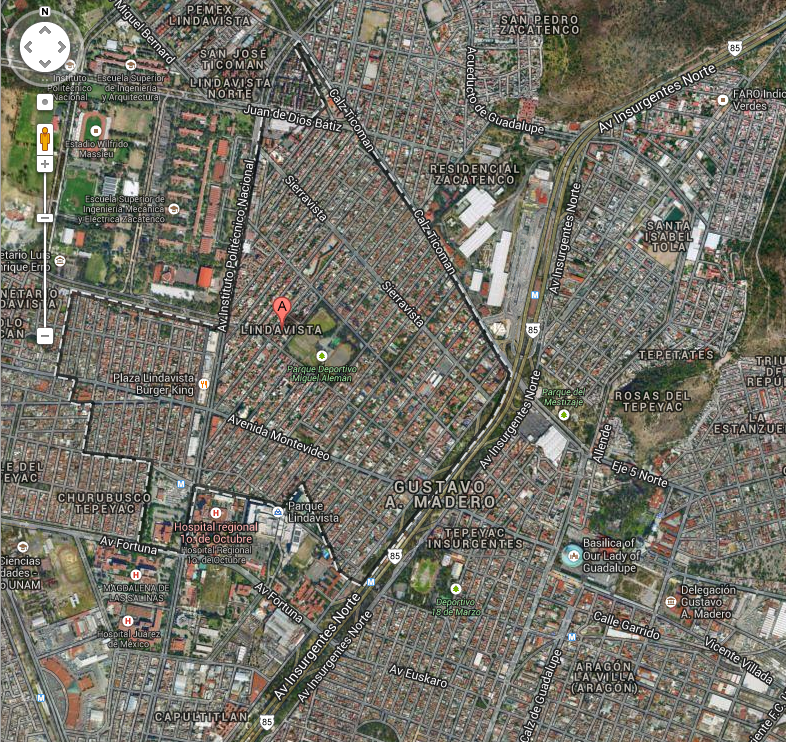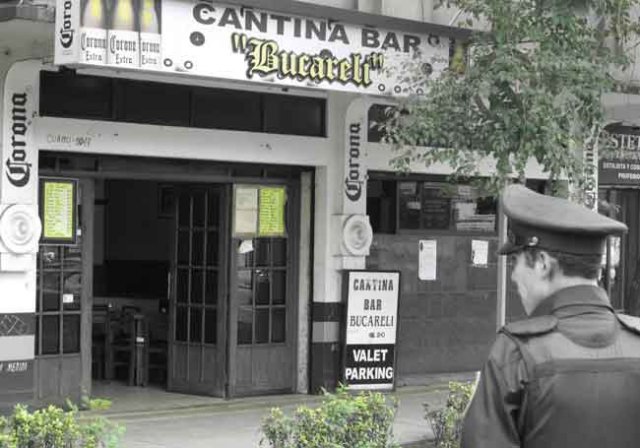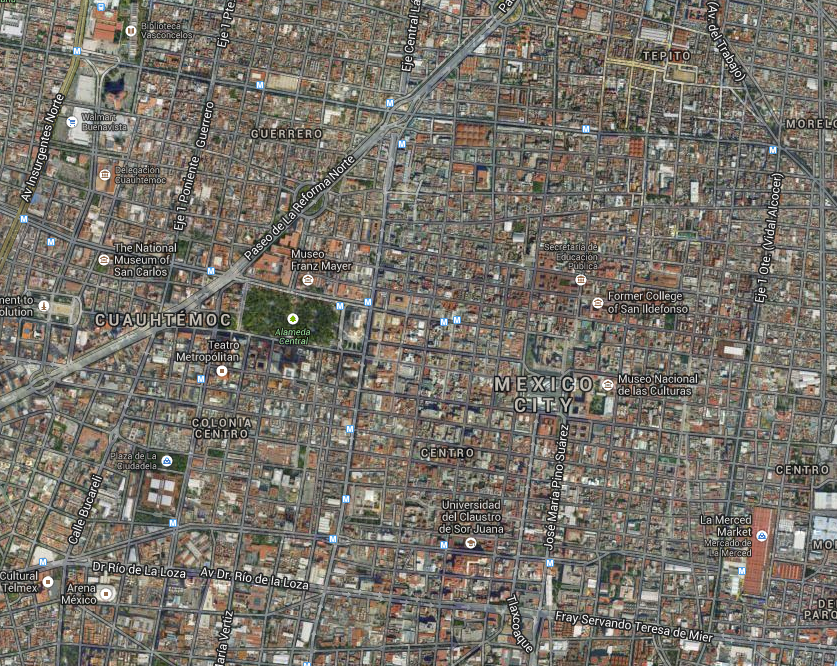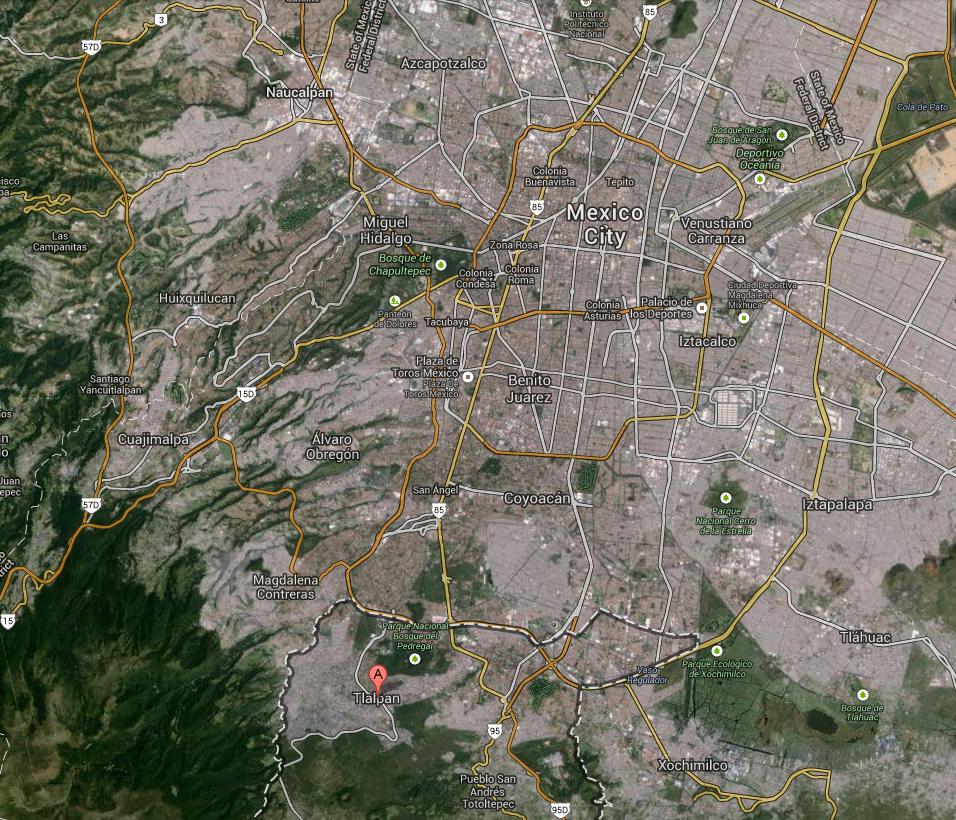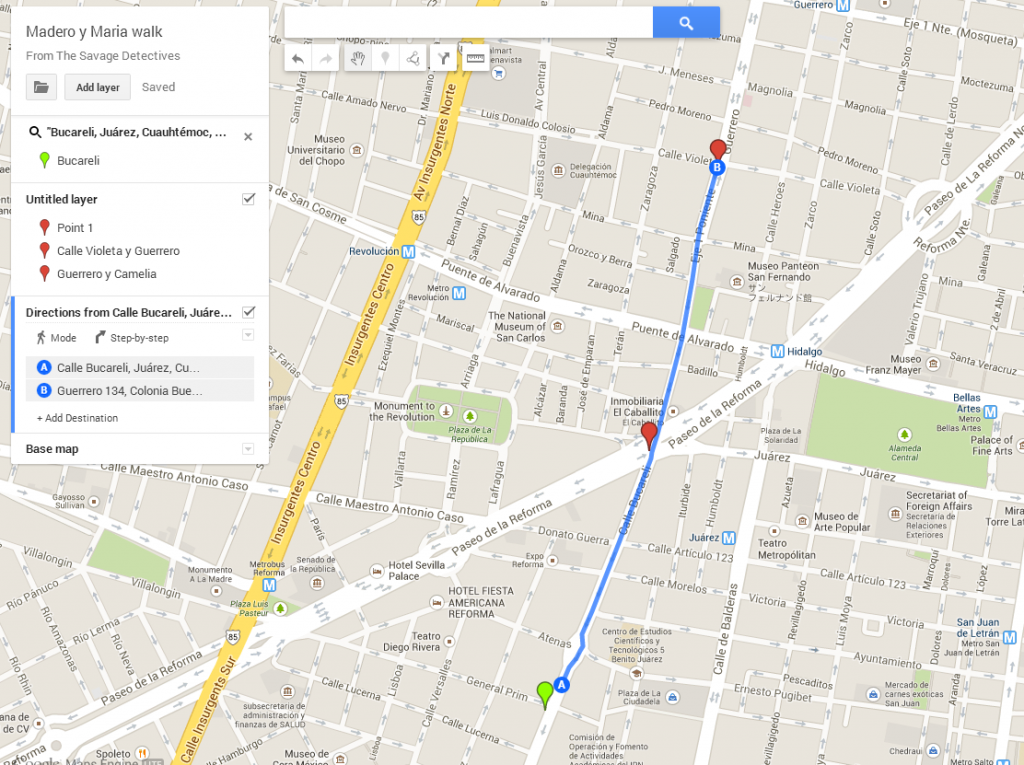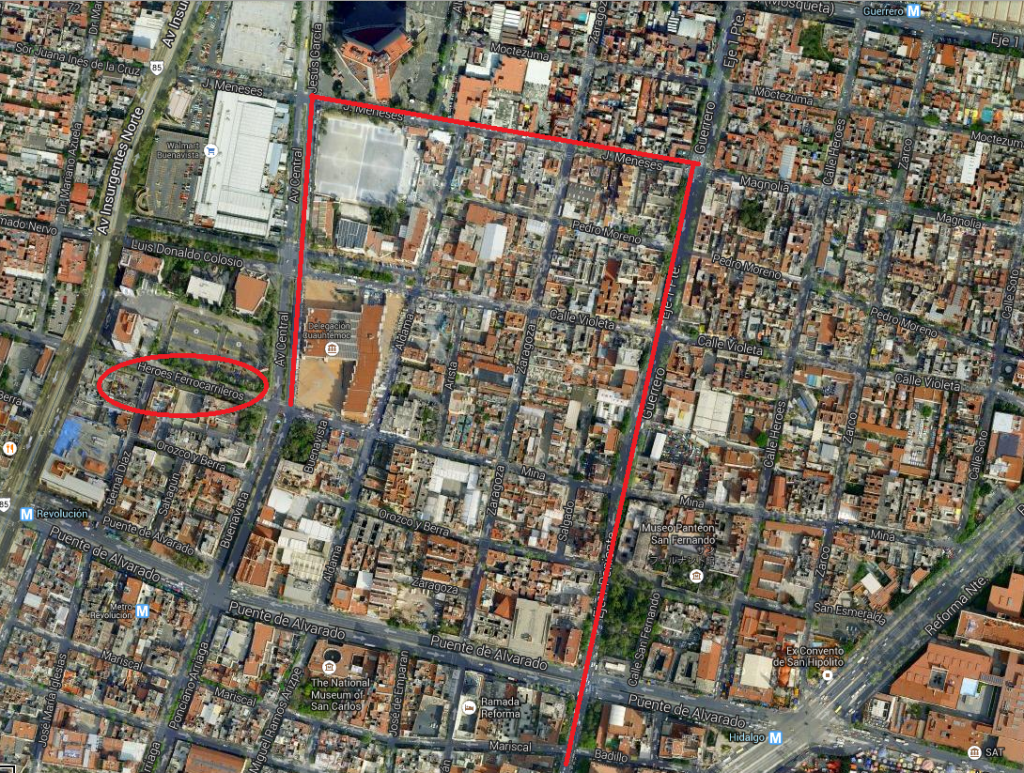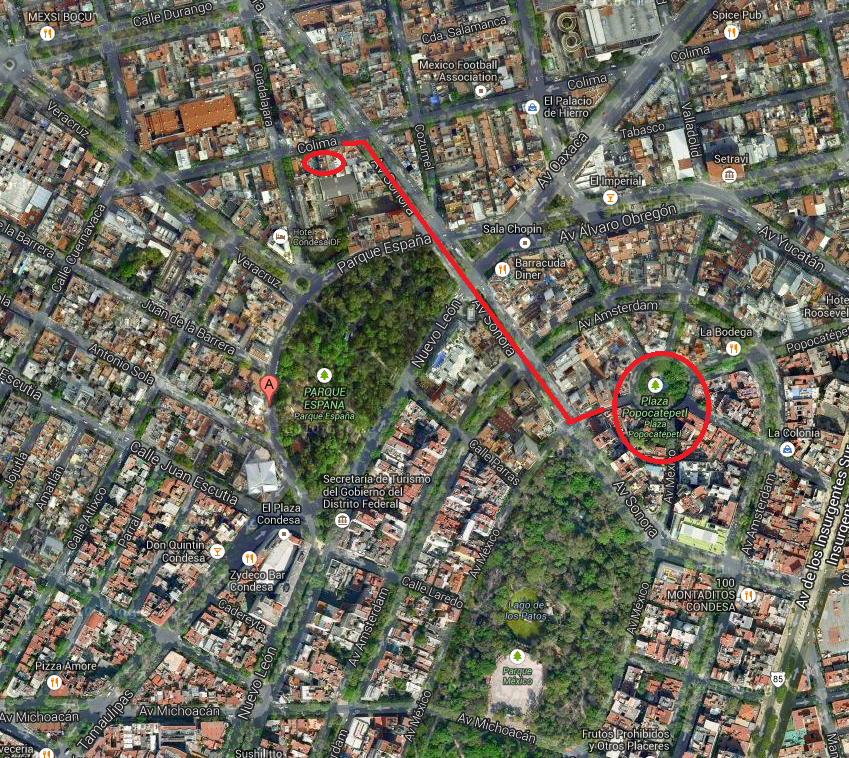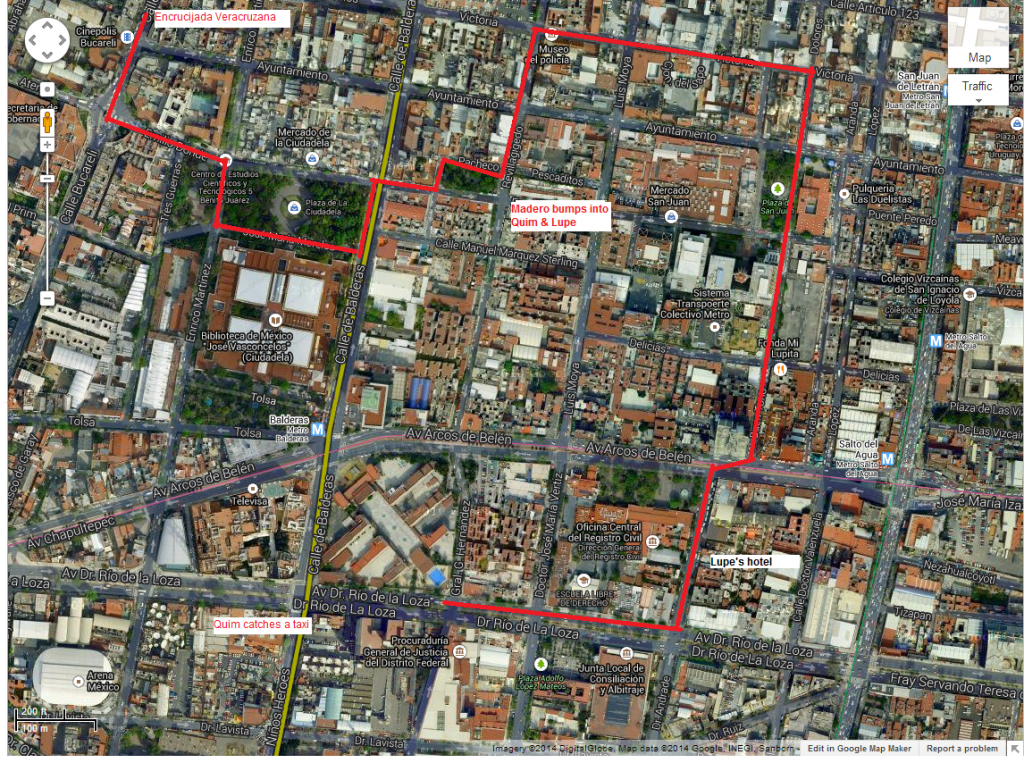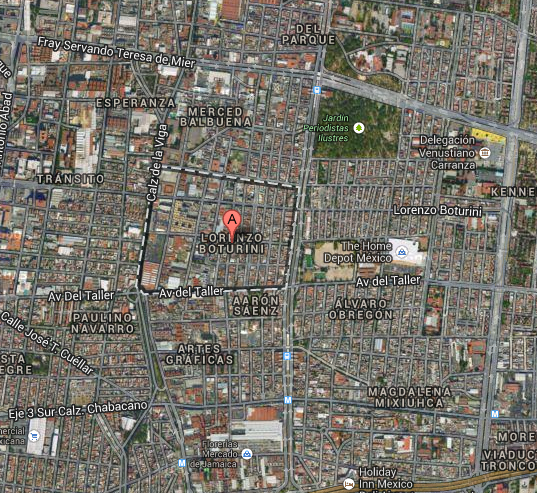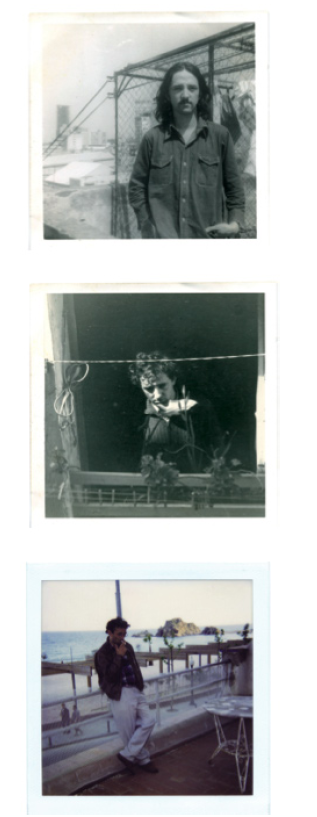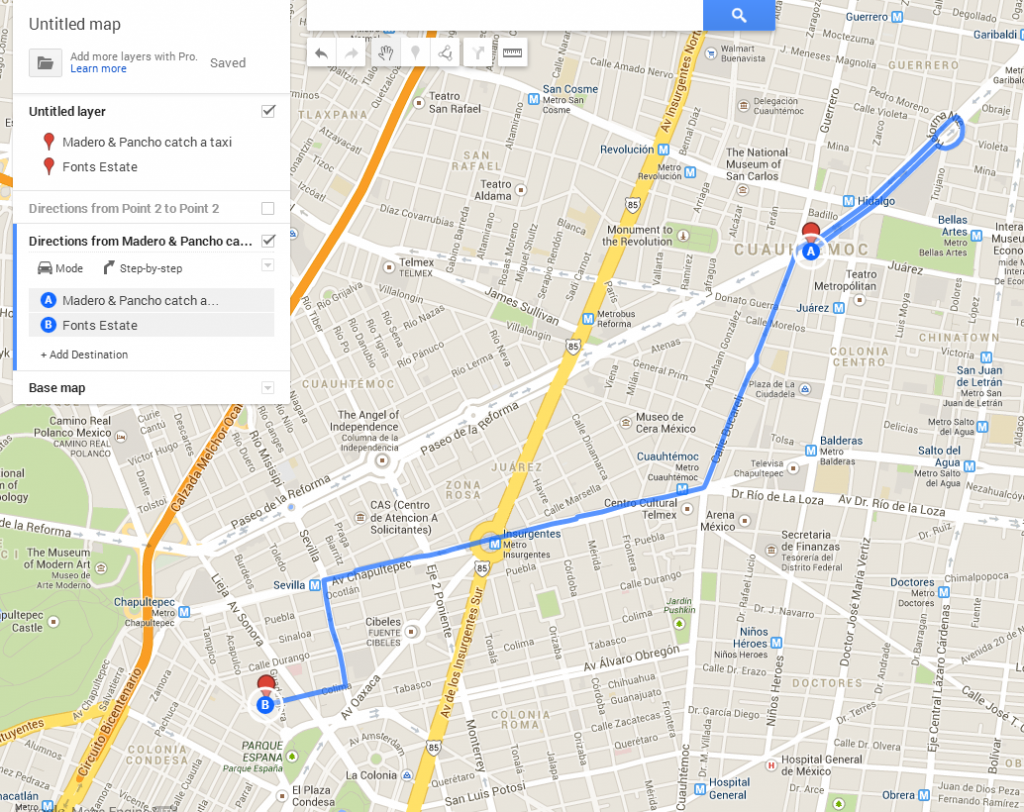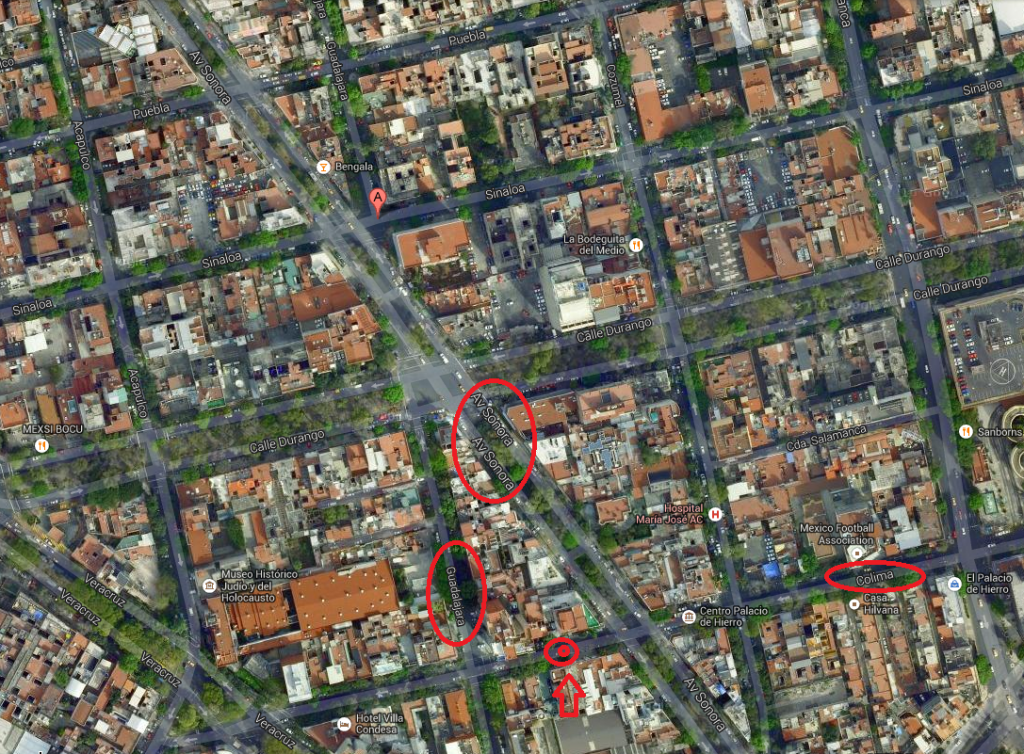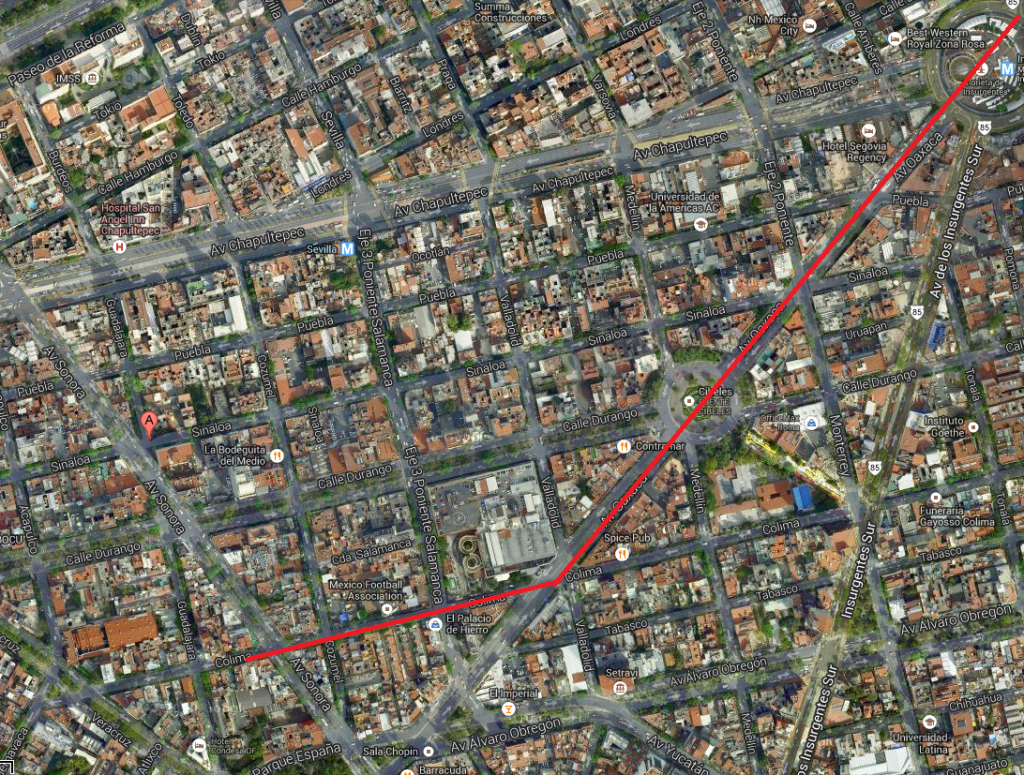Bolaño burst onto the American literary scene in 2007—four years after his death—with The Savage Detectives. The long novel is divided into three sections: I) Mexicans Lost in Mexico (1975), II) The Savage Detectives (1976-1996), and III) The Sonora Desert (1976).
I started working on this post about locations in The Savage Detectives four years ago. I plotted some of the maps out shortly after I had mapped out some of the Mexico City locations in 2666. In our 2009 group read of 2666, we also created a map of most of the locations mentioned in all five sections of that novel. In the time since then, Gabe Habash has published a wonderful map of the road trip that takes place in third section of The Savage Detectives.
Many people read the fairly short first section of the novel, which is narrated by Juan Garcia Madero and hopscotches around the tangle of streets in Mexico City, and loved it, but were often put off by the second lengthy section of interviews. Some called it a slog and didn’t see how that second section tied in with the rest of the book.
I’m also interested in that first section (all the sections, really) and so I’m going to focus on the geography of Mexico City described in the novel’s opening 120 pages. Let me also start with the caveats that I have not been to Mexico City, I do not speak Spanish, and that in fact, the geography of the book is one of the hooks for me “into†the book. Imagining the passage of people through spaces helps me see the story differently than I otherwise might.
At one point, Juan Garcia Madero is inside the Fonts’ walled estate and he is so immersed in that environment that he can’t believe “Mexico City is really out there.†That’s how I feel. I’m so immersed in my own little world that I forget that I’m actually surrounded by a vibrant city, state, country, and continent.
I also realize that Bolaño is describing a Mexico City of 38 years ago and that many of the places he’s describing have vanished or changed, and are not visible in Google Street View, but the general layout of the streets has not changed. And it seems that Bolaño derives great pleasure from mentally re-walking the streets of his youth, describing elaborate routes and recalling exact street names. I hope someone with more knowledge than I will leave a comment explaining where I have erred and what I have missed.
The page numbers below correspond to the 2012 Picador UK edition of the novel.
SECTION I: Mexicans Lost in Mexico
p. 6 – Madero, Lima, and Belano take a pesero to Reforma, from there they walk to a bar on Calle Bucareli. Reforma is a huge avenue in DF. Here’s a look at the intersection of Reforma and Bucareli:
That yellow statue is in front of a skyscraper called the Torre del Caballito.
Could this be the bar they visit?
Probably not (see below).
p. 7—We learn that Madero lives in Colonia Lindavista {Lindavista is located in the borough of Gustavo A. Madero}; he goes back to the bar on Bucareli.
[Note that Insurgentes runs right through the neighborhood. It is the main artery of traffic here.]
p.8—After a brief mention of the sewers of Chapultepec, Madero is back in the bar on Bucareli. We learn that the bar is called Encrucijada Veracruzana.
This guy claims to have taken photos of many of the real places in The Savage Detectives, including Encrucijada Veracruzana (which roughly translates to “Crossroads of Veracruz”; later on we find out that Rosario, the waitress, is from Veracruz).
This “Cantina Bar Bucareli” still exists at 66 Calle Bucareli.
p. 10—Madero takes the UNAM bus and wanders around “downtown†where he stops at a bookstore called   “LibrerÃa del Sótano.” He then crosses Juarez and eats his lunch in the Alameda.
“Downtown” is essentially “Centro”, or the area around the historic city center – the Zocalo. The Alameda park Madero visits is the western border of “downtown.”
Júarez is the street on the southern border of the Alameda, implying that the bookstore is right there on Júarez or very nearby. And, in fact, if you waltz down Júarez, you’ll see the bookstore, called “LibrerÃas del Sótano,” is still there:
Here is a park bench in the Alameda:
Madero then spent the evening on Calle Corazón (which is one block over from where Madero lives in Colonia Lindavista). I think this is a fictional street name, but Madero says he watches a soccer game being played there and there is one soccer pitch right in the middle of Lindavista, bordering Calle Lima. I’m going to consider that a nod to Ulises Lima. Or vice-versa.
pp. 12-13—Madero goes to Café Quito on Bucareli, which is a little past the Encrucijada. The real-life Cafe Quito, confirmed by Bolaño’s translator, is a place called Cafe La Habana.
View Larger Map
Maria Font’s house is in Colonia Condesa; Catalina O’Hara’s house in Colonia Coyoacán.
Colonia Condesa is right next to Chapultepec.
And Coyoacán, the famous artist’s district once home to Frida Kahlo, is farther south, down near UNAM.
View Larger Map
p. 18—Ulises Lima lives in a room on a rooftop on Calle Anahuac, near Insurgentes.
Here is Anahuác, just off Insurgentes. Could that be Lima’s place up there?
p. 19—they steal books from the Libreria Francesca in the (upscale) Zona Rosa and from the Libreria Baudelaire on Calle General Martinez, near Calle Horacio in Polanco.
“Libreria Francesca” just means “French bookstore” and in fact there is a real French-language bookstore in Zona Rosa, also called Temps de Lire. The LibrerÃa Baudelaire is actually a bookstore in Santiago, Chile, that Bolaño here seems to have superimposed onto Mexico City.  The Avenida Horacio (not Calle) in Polanco (just north of Chapultepec) doesn’t appear to have a “Calle General Martinez” anywhere near there. However, Polanco is interesting in that it has streets named after Horace (Horacio), Plato, Socrates, Aristotle, Archimedes, Hesiod, Ibsen, Racine, Homer, Pascal, Galileo, Cicero, Pliny, Sophocles, Seneca, Moliere, Jules Verne, Oliver Goldsmith, Edgar Allan Poe, Lafontaine, Anatole France, Dumas, Tennyson, Emerson, Schiller, Isaac Newton, Hegel, and Euler among others. No doubt this appealed to Bolaño.
p. 22—the Fonts live in Colonia Condesa on Calle Colima. Colima sort of dead-ends on the eastern edge of Condesa, so I’m assuming it’s that end of Colima that houses the Font estate. In that last block of Colima is now the Museo Histórico JudÃo y del Holocausto.
p. 26—Pancho and Madero meet at El Loto de Quintana Roo, a Chinese café (where they drink coffee) near the Glorieta de Insurgentes. “El loto” means the lotus and Quintana Roo is a state in the Yucatan. It’s a funny image. The Glorieta de Insurgentes is a large monument in a traffic circle on Insurgentes.
Note that just off Avenida Chapultepec is Calle Amberes. Amberes (or Antwerp) is the title of Bolaño’s short, seminal work of experimental fiction. Pancho and Juan then head for the Fonts’ home in Colonia Condesa (p. 27).
p. 29—We learn that Laura Damian died when she was struck by a car in Tlalpan, which is on the southern edge of D.F., south of Coyoacán.
pp. 32-33—Maria meets Garcia Madero at Café Quito. They leave and walk along Bucareli toward Reforma, then cross Reforma and head up Avenida Guerrero. Maria says “this is where the whores are.†Basically, they are just walking north on Bucareli as it turns into Guerrero north of Reforma. They continue north past Violeta and Magnolia, “Someday I’m going to live here,†she says. [Calle Magnolia is called “J. Meneses” west of Guerrero.]
p. 34—We learn the dance school Maria attends is on Donceles. Donceles is just  a  couple of blocks off the Zocalo and is indeed in the arts district where there are several theaters, museums, and dance companies.
They turn left on Magnolia, on to Avenida Jesus Garcia, then walk south to Heroes Revolucionarios Ferrocarrileros, where they go into a coffee shop. (Magnolia changes into J. Meneses, and then into Sor Juana Ines de la Cruz. In this section of the novel, Madero makes a “banal remark” about Sor Juana to Maria and she judges him harshly—he avoids the topic of Sor Juana after that. {You can also see here how frequently streets change names. Stay on one DF street long enough and it is certain to be called something else. Bolaño says “Every hundred feet the world changes.”}) I’m not sure who “J. Meneses” commemorates. Perhaps this Chilean priest?
If they go east on Heroes/Mina, all the way back to Guerrero, they will have just made a circle.
p. 37—Lupe tells the story of how she got beat up and sat down on a bench in the Plaza San Fernando to die. You can see “Calle San Fernando” and the adjacent plaza in the picture just above (in the lower right corner). The park benches there have a unique look.
View Larger Map
When Lupe’s son died, she was living in a building on Paraguay, near the Plaza de Santa Catarina. After that story, there is a lot of back and forth to the Fonts’ house.
p. 58—Pancho and Garcia Madero leave the Fonts’ House in Colonia Condesa. They walk through the Parque España, down Parras, through the Parque San Martin, and along Teotihuacan. They get to Insurgentes, then head down Manzanillo, turn onto Aguascalientes, then south again onto Medellin, walking until they reach Calle Tepeji, stopping in front of a five-story building. This is a fairly easy route to follow on Google Maps and gives us a better idea of where exactly on Colima the Fonts live: likely in the block between Guadalajara and Sonora. Here is the route, starting on Colima, down through the two parks, across Insurgentes and south on Manzanillo.
And here’s the rest of the route: south on Manzanillo, to Aguascalientes, to Medellin, to Tepeji.
Somewhere on that block of Tepeji they go into a five story building. All of the buildings on this block are two-story, except for the one right at the corner of Medellin, which is blue and five stories tall.
View Larger Map
p. 59—From the roof of that building they can see the lots of the Parque de las Americas, the Medical Center, the Children’s Hospital, and the General Hospital. Although, I don’t think there is any park called that per se – the park here is Jardin Ramon Lopez Velarde.
p. 65—Madero goes to the bus stop on Insurgentes, but then decides to go back to the Fonts’ house.
Here is the nearest bus stop on Insurgentes.
View Larger Map
Madero calls Maria Font and tells her he is near her house, at Plaza Popocatépetl. (Note here that Avenida Sonora connects the Plaza and Colima, Font’s street. Section III of The Savage Detectives is called “The Sonora Desert.”)
Madero waits in the Plaza for two hours, writing in his journal and reading a book of poems, before venturing back over to the Fonts’ estate.
p. 75 – Madero and Maria go to a lecture by Octavio Paz. They meet Ernesto at the lecture, at the Capilla Alfonsina. Afterward they go to a restaurant on Calle Palma called La Palma de la Vida.
Some of the following pages mention places we’ve already visited: Reforma, Cafe Quito, Bucareli, etc.
p. 79 – Madero sleeps with Rosario “at her place, a crummy tenement building way out in the Colonia Merced Balbuena, near the Calzada de la Viga.” Â Here is just such a building:
View Larger Map
pp. 81-86 – Madero leaves the Encrucijada Veracruzana (on Bucareli) and “turns the corner” at the Reloj Chino and walks toward La Ciudadela, looking for a cafe where he can write. He crosses the Jardin Morelos, crosses Niños Heroes (also called Calle de Balderos), Plaza Pacheco, and is about to turn up Revillagigedo toward the Alameda when Quim Font and Lupe surprise him. They turn right on Victoria to Dolores and go into a Chinese cafe. They leave the cafe at one in the morning and go looking for a hotel. They finally find one on Rio de la Loza called Media Luna and leave Lupe there. Quim and Garcia Madero keep walking toward Reforma and Quim takes a taxi at Niños Heroes.
p. 90 – Madero looks for Belano and Ulises Lima in bookstores, starting with “Plinio el Joven, on Venustiano Carranza” then the “Lizardi bookstore on Donceles” and the “antiquarian bookstore Rebecca Nodier” at Mesones and Pino Suarez.
Calle de Venustiano Carranza is a shopping district just south of the Zocalo. I didn’t see any bookstores on the street now, or anything called Pliny the Younger, but there is a restaurant called Bolaño’s.
Calle Donceles is a used bookstore mecca. There are at least a dozen used bookstores in this one street.
There are no bookstores there any longer, but here is the intersection of Mesones and Pino Suarez:
pp. 91-92 – Madero again visits a bunch of bookstores: LibrerÃa del Sotano on Juarez, LibrerÃa Mexicana on Calle Aranda, near the Plaza de San Juan, the LibrerÃa Pacifico at Bolivar and 16 de Septiembre, the Viejo Horacio on Correo Mayor, LibrerÃa Orozco on Reforma between Oxford and Praga, LibrerÃa Milton at Milton and Darwin, and the LibrerÃa El Mundo on Rio Nazas.
We’ve already visited the LibrerÃa del Sotano on Juarez (above), but the LibrerÃa Mexicana on Calle Aranda, near the Plaza de San Juan, is long gone, replaced by a district of chicken restaurants.
The LibrerÃa Pacifico at Bolivar and 16 de Septiembre is also either gone or fictional, but on that same block (and coincidentally, somewhat closer to Avenida Francisco Madero) is the American Bookstore.
The Viejo Horacio on Correo Mayor is also in the general vicinity of these other locations, Centro. No Old Horace bookstore there, though. The LibrerÃa Orozco on Reforma between Oxford and Praga, if it existed, would be here:
The LibrerÃa Milton at Milton and Darwin is near Polanco, on this block:
Finally, the LibrerÃa El Mundo on Rio Nazas is also non-existent, but, for effect, here is a bookstand on Rio Nazas:
Rio Nazas seems to be a fairly upscale street, home to the French Embassy, a yoga studio, cafes, etc.
For more on bookstores in Mexico City, there is a good (English-language) walking tour here.
pp. 97-99 – Madero goes to Cafe Quito, walks to Montes, where Jacinto lives, then wanders around after calling the Fonts’, before finding himself in a “bleak stretch of Colonia Anahuac, surrounded by dying trees and peeling walls.” He goes into a place on Calle Texcoco and drinks coffee then calls Angelica Font again. Later he walks back to Sullivan and as he crosses Reforma, near the statue of Cuauhtemoc, he runs into Belano and Ulises Lima.
There are several mentions of “Calle Montes” in the book, but I couldn’t find it. Maybe that street has been renamed? We do know that it’s near the Monument to the Revolution, which is between Bucareli (A) and Anahuac (C).
There is still plenty of peeling paint and dying trees in Anahuac.
Here is Madero’s route back from Anahuac to Reforma, where he runs into Belano and Lima (and then wakes up in Rosario’s room out in Merced Balbuena).
p. 106 – Madero and Rosario walk to a bathhouse on Calle Lorenzo Boturini called “El Amanuense Azteca.”
You can see that Lorenzo Boturini is the name of a neighborhood directly south of Merced Balbuena, and Lorenzo Boturini is the name of the main avenue in that neighborhood.
There is no bath house there, but there is a gym on Lorenzo Boturini:
View Larger Map
p. 109 – Garcia Madero wanders around downtown, stopping by the Zócalo and ending up at a café on Madero called Nueva SÃbaris (new Sybaris implies something erotic there and indeed Pancho recounts his night of whoring for Madero there).
The Zócalo, where Madero’s “pores opened up at last”:
The borough is called “Gustavo Madero,” but the avenue just off the Zócalo is “Francisco I. Madero.” On this avenue is a Gandhi Books store (there are several in DF). It was in Gandhi Books in 1976 where Bolaño stood up and first read the Infrarealist Manifesto.
I’m fairly certain that the Gandhi Books Bolaño stole from and read at is this one on Juarez, near LibrerÃas del Sótano and the Alameda.
[photos from CCCB touring dossier]
p. 110 – Madero and Pancho catch a taxi at Reforma and Juárez (Francisco I. Madero turns into Juárez) and head back toward the Fonts’ house on Calle Colima in Colonia Condesa.
[click the image]
p. 116 – Madero is at the Fonts’ house and hears sounds of a party from one of the houses on Calle Guadalajara or Avenida Sonora. This allows us, finally, to pinpoint the exact block of the Fonts’ house. It seems safe to assume here that it is on Calle Colima between Guadalajara and Sonora.
Most of the buildings on that block are now large medical offices or multi-story apartment buildings, but there are a couple of single-family homes left on the south side of the street.
p. 120 – a brief mention of Calle Cuernavaca, which Colima dead-ends into in the west.
p. 124 – Ulises Lima, Belano, Garcia Madero, and Lupe make their escape from Calle Colima in Quim’s Impala. In “less than two seconds we were on Avenida Oaxaca, heading north out of the city.”
Many of the same locations show up in Part II of the novel. I’m working on mapping those, but will have to break the locations into five or six posts.
